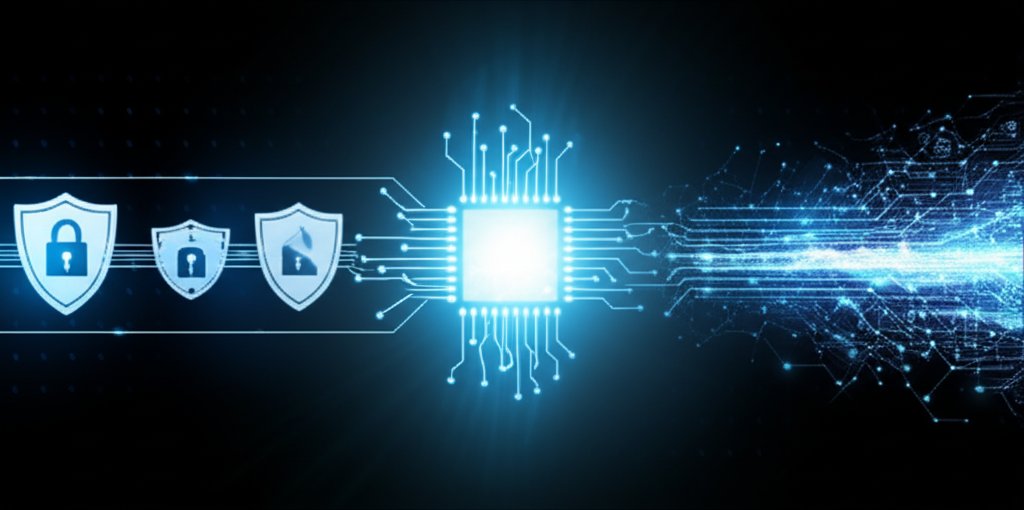Artificial Intelligence (AI) is rapidly transforming every sector, and digital security and compliance are no exception. For small businesses and everyday users, the constant buzz around AI can be confusing: what’s a genuine security advantage and what’s just marketing hype? As a security professional, my aim is to cut through that noise. We’ll explore what AI truly offers for your digital defenses and what potential pitfalls you need to understand. From AI-powered spam filters blocking phishing attempts to systems detecting unusual login patterns, AI is already at work, making security smarter. Let’s demystify its role in helping you take control of your digital safety.
Cutting Through the AI Hype: From Buzzwords to Business Benefit
You’ve seen the headlines, haven’t you? AI is often presented as a panacea for all our problems, or conversely, as a harbinger of new dangers. This technology is advancing at an incredible pace, naturally generating significant excitement and discussion. However, this rapid evolution often leads to a “hype cycle” where capabilities are exaggerated and expectations skyrocket. In complex and high-stakes fields like cybersecurity and compliance, such hype can lead to considerable confusion. It’s why we must ground our understanding in reality.
AI in Action: Practical Applications for Your Digital Defenses
When we discuss AI in cybersecurity, we’re not envisioning sentient robots guarding your network—at least not yet! Instead, we’re focusing on the practical applications of machine learning and advanced pattern recognition. Imagine AI as a tireless, ultra-fast analyst. It can rapidly process vast amounts of data, far beyond human capacity, to identify anomalies, recognize patterns, and make informed predictions. This helps your systems learn from past incidents and proactively adapt to new threats. Essentially, AI automates mundane tasks and injects intelligence into data analysis, enabling your security tools to work smarter, not just harder.
AI’s core function is to augment human efforts, not replace them. It makes your existing defenses more proactive and responsive. For example, AI can swiftly identify suspicious emails indicating phishing attempts, flag unusual network activity that might signal a breach, or automate routine security checks that would otherwise consume valuable human time. It’s like equipping your security team with a powerful magnifying glass and an indefatigable assistant, freeing them for more complex strategic challenges.
Debunking the Hype: Common AI Security Myths
Let’s address some of the biggest misconceptions head-on. It’s easy to get swept up in the narrative, but understanding what AI isn’t is just as important as knowing what it is.
Myth 1: AI is a “Magic Bullet” for Absolute Security.
Reality: While AI is a powerful tool, it’s crucial to understand it’s one component within a robust, multi-layered cybersecurity strategy. It enhances your defenses, but it doesn’t create an impenetrable fortress. Remember, cybercriminals are also leveraging AI, developing more sophisticated and evasive attacks. Relying solely on AI without strong foundational security practices is akin to donning a superhero cape but forgetting your sturdy boots—you remain vulnerable where it matters most.
Myth 2: AI Will Completely Replace Human Security Experts.
Reality: This is a common fear, but it’s misplaced. While AI can automate routine, repetitive tasks, human oversight, critical thinking, and nuanced decision-making remain absolutely indispensable. AI might flag a suspicious event, but a human expert is still needed to interpret the context, understand the attacker’s motive, and formulate a strategic response. AI handles the grunt work, freeing up human professionals for the complex problem-solving that only we can do.
Myth 3: AI is Always 100% Accurate and Infallible.
Reality: AI systems are only as good as the data they’re trained on. If that data is flawed, incomplete, or biased, the AI will reflect those imperfections. This can lead to errors, such as generating too many false alarms (false positives) that distract your team, or worse, missing genuine threats (false negatives). AI is a learning system, and like any learner, it can make mistakes.
Myth 4: AI Security Solutions Are Only for Large Corporations.
Reality: This couldn’t be further from the truth today. Thanks to cloud computing and the integration of AI into everyday software, scalable and affordable AI security tools are increasingly accessible for small businesses and even individual users. Your email provider’s spam filter, your mobile phone’s facial recognition, or your antivirus software often uses AI behind the scenes. It’s already there, quietly working for you.
The Reality: How AI Can Genuinely Benefit Your Security & Compliance
Now that we’ve cleared up some misconceptions, let’s focus on the genuine, practical advantages AI can bring to your security and compliance efforts.
Smarter & Faster Threat Detection
One of AI’s strongest suits is its ability to analyze massive datasets in real-time, identifying anomalies and potential threats that human eyes would surely miss. For example, AI in your antivirus software can detect new, previously unknown malware variants by recognizing their behavioral patterns. Similarly, AI-powered email filters are incredibly effective at flagging advanced phishing attempts by analyzing subtle cues in language and sender reputation. It provides real-time monitoring of your online activity and devices, catching suspicious patterns before they escalate.
Automating Tedious Security Tasks
AI excels at taking over repetitive, labor-intensive tasks, reducing the burden on human staff and minimizing human error. Think about how AI can automatically flag risky files, streamline vulnerability scans, or simplify the triage of security alerts. This not only makes your security posture more efficient but also frees up your team to focus on more strategic, complex issues.
Boosting Data Privacy & Regulatory Compliance
For small businesses, navigating the labyrinth of data privacy regulations like GDPR, CCPA, or HIPAA can feel overwhelming. AI can be a game-changer here. It can help you automatically categorize sensitive data, monitor who accesses it, and track data flows to ensure compliance. It makes it easier to generate audit reports and respond to data subject requests. For everyday users, AI in reputable online services (like those managing your cloud storage or social media) plays a role in helping them protect your data and manage your privacy settings, often without you even realizing it.
Enhancing Incident Response
When a security incident occurs, every second counts. AI can dramatically speed up incident response by quickly identifying the scope of a breach, pinpointing affected systems, and even suggesting remediation steps. It helps your team prioritize responses, guiding them through the necessary actions to contain and recover from threats efficiently. This reduces the overall impact of an attack.
Navigating the Downsides: Real Risks & Limitations of AI in Security
While AI offers incredible benefits, it’s not without its challenges. Being aware of these risks is key to leveraging AI responsibly.
Data Privacy Concerns
AI systems thrive on data – the more, the better. This constant hunger for information raises critical questions about how that data is collected, stored, and protected. If sensitive personal or business data is fed into an AI system without robust safeguards, it could become a single point of failure, increasing the risk of a breach. We must ensure AI isn’t just a powerful tool, but a secure one.
Algorithmic Bias
As we mentioned, AI is only as good as its training data. If that data contains inherent biases (e.g., historical security data that disproportionately flagged certain demographics), the AI can perpetuate or even amplify those biases. This could lead to unfair or discriminatory security outcomes, like falsely flagging legitimate users or overlooking threats from certain sources. It’s a subtle but significant risk we need to actively manage.
New Avenues for Cyberattacks
Cybercriminals are innovative, and they’re constantly finding new ways to exploit technology. With AI, they can use “adversarial attacks” to trick AI systems. This might involve subtly altering malware code to bypass an AI-powered detector or poisoning training data to corrupt an AI’s learning process. It’s a constant arms race, and AI itself can become a target.
The Danger of Over-Reliance
Blindly trusting AI without understanding its mechanisms or potential flaws can be incredibly risky. If you delegate too much decision-making authority to an AI system without human review or fallback procedures, you could be left vulnerable when the AI inevitably makes an error or encounters a scenario it wasn’t trained for. We must maintain a healthy skepticism.
Practical Steps for Everyday Users & Small Businesses to Leverage AI Safely
So, what can you do to harness the power of AI while staying safe?
Don’t Skip the Basics: AI is an Add-on, Not a Replacement!
I can’t stress this enough: AI enhances good security, it doesn’t excuse bad habits. You still need strong, unique passwords (and ideally, a password manager!), multi-factor authentication (MFA) on all your accounts, regular software updates, and basic security awareness training for yourself and any employees. These fundamentals are your first line of defense.
Be an Informed Consumer: Ask Questions!
When you’re considering AI-powered tools or services, don’t be afraid to ask direct questions. Inquire with vendors: “How does this AI use my data?” “What measures are in place to prevent bias?” “Is human review part of the process?” “How does it protect against new, unknown threats?” Transparency is key, and if they can’t give you clear answers, that’s a red flag.
Prioritize Reputable Vendors & Integrated Solutions
Stick with established security providers that have a proven track record and clearly explain their AI’s capabilities and limitations. Often, the best AI features are already built into existing, trusted tools like your operating system’s security features, popular antivirus programs, or email services. These providers invest heavily in ethical AI development and robust security.
Maintain Human Oversight & Continuous Learning
Even with advanced AI, a human touch is essential. Regularly review security reports, stay informed about new threats, and continuously educate yourself and your team about cybersecurity best practices. For businesses, assign someone to monitor AI outputs and intervene when necessary. This helps you automate tasks without losing critical control.
Strengthen Your Data Protection Practices
If you’re integrating AI into your business, it’s more important than ever to implement robust data protection. This means encrypting sensitive data, establishing strict access controls for AI systems, and having clear data retention policies. Understand what data your AI uses and ensure it’s handled with the utmost care.
The Future of AI in Security Compliance: A Balanced Perspective
AI will undoubtedly continue to reshape the cybersecurity landscape. We’ll see more sophisticated threat detection, even greater automation, and new ways to stay ahead of cybercriminals. However, it will also introduce new challenges and attack vectors.
The key for everyday users and small businesses is to approach AI with a balanced view. Understand its true capabilities, appreciate its genuine benefits, but always remain vigilant about its risks and limitations. AI is a powerful ally, but it’s not a substitute for fundamental security practices and sound human judgment. Protect your digital life! Start with a password manager and 2FA today.


